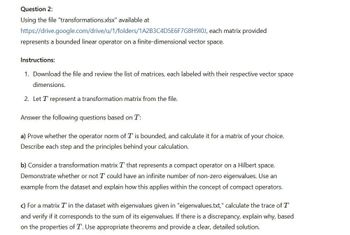
Elementary Linear Algebra (MindTap Course List)
8th Edition
ISBN: 9781305658004
Author: Ron Larson
Publisher: Cengage Learning
expand_more
expand_more
format_list_bulleted
Question

Transcribed Image Text:Question 2:
Using the file "transformations.xlsx" available at
https://drive.google.com/drive/u/1/folders/1A2B3C4D5E6F7G8H910J, each matrix provided
represents a bounded linear operator on a finite-dimensional vector space.
Instructions:
1. Download the file and review the list of matrices, each labeled with their respective vector space
dimensions.
2. Let T represent a transformation matrix from the file.
Answer the following questions based on T:
a) Prove whether the operator norm of T is bounded, and calculate it for a matrix of your choice.
Describe each step and the principles behind your calculation.
b) Consider a transformation matrix T that represents a compact operator on a Hilbert space.
Demonstrate whether or not I could have an infinite number of non-zero eigenvalues. Use an
example from the dataset and explain how this applies within the concept of compact operators.
c) For a matrix T in the dataset with eigenvalues given in "eigenvalues.txt," calculate the trace of T
and verify if it corresponds to the sum of its eigenvalues. If there is a discrepancy, explain why, based
on the properties of T. Use appropriate theorems and provide a clear, detailed solution.
Expert Solution
This question has been solved!
Explore an expertly crafted, step-by-step solution for a thorough understanding of key concepts.
Step by stepSolved in 2 steps

Knowledge Booster
Similar questions
- Determine if the statement is true or false. If the statement is false, then correct it and make it true. For the product of two matrices to be defined, the number of rows of the first matrix must equal the number of columns of the second matrix.arrow_forwardShow that the matrix below does not have an LU factorization. A=0110arrow_forwardPlease helparrow_forward
- The sequence of numbers we’re generating are traditionally constructedlike this: Start with the first 2 numbers. To get the next number, take the 2most recent numbers and add them together to get the next one.Explain why our matrix vector multiplication is generating the same numbersas the traditional procedure.arrow_forwardIf the null space of a 30x17 matrix is 13-dimensional, find the rank of the matrix.arrow_forwardand u = Write y as the sum of two orthogonal vectors, one in Span {u} and one orthogonal to u. Let y = (Type an integer or simplified fraction for each matrix element. List the terms in the same order as they appear in the original list.) Enter your answer in each of the answer boxesarrow_forward
arrow_back_ios
arrow_forward_ios
Recommended textbooks for you
 Elementary Linear Algebra (MindTap Course List)AlgebraISBN:9781305658004Author:Ron LarsonPublisher:Cengage Learning
Elementary Linear Algebra (MindTap Course List)AlgebraISBN:9781305658004Author:Ron LarsonPublisher:Cengage Learning Algebra & Trigonometry with Analytic GeometryAlgebraISBN:9781133382119Author:SwokowskiPublisher:Cengage
Algebra & Trigonometry with Analytic GeometryAlgebraISBN:9781133382119Author:SwokowskiPublisher:Cengage College Algebra (MindTap Course List)AlgebraISBN:9781305652231Author:R. David Gustafson, Jeff HughesPublisher:Cengage Learning
College Algebra (MindTap Course List)AlgebraISBN:9781305652231Author:R. David Gustafson, Jeff HughesPublisher:Cengage Learning
 Linear Algebra: A Modern IntroductionAlgebraISBN:9781285463247Author:David PoolePublisher:Cengage Learning
Linear Algebra: A Modern IntroductionAlgebraISBN:9781285463247Author:David PoolePublisher:Cengage Learning

Elementary Linear Algebra (MindTap Course List)
Algebra
ISBN:9781305658004
Author:Ron Larson
Publisher:Cengage Learning


Algebra & Trigonometry with Analytic Geometry
Algebra
ISBN:9781133382119
Author:Swokowski
Publisher:Cengage

College Algebra (MindTap Course List)
Algebra
ISBN:9781305652231
Author:R. David Gustafson, Jeff Hughes
Publisher:Cengage Learning


Linear Algebra: A Modern Introduction
Algebra
ISBN:9781285463247
Author:David Poole
Publisher:Cengage Learning